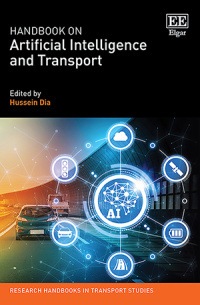
Hardback
Handbook of Choice Modelling
Second Edition
2nd edition
9781800375628 Edward Elgar Publishing
This thoroughly revised second edition Handbook provides an authoritative and in-depth overview of choice modelling, covering essential topics range from data collection through model specification and estimation to analysis and use of results. It aptly emphasises the broad relevance of choice modelling when applied to a multitude of fields, including but not limited to transport, marketing, health and environmental economics.
More Information
Critical Acclaim
Contributors
More Information
This thoroughly revised second edition Handbook provides an authoritative and in-depth overview of choice modelling, a key technique used across disciplines as diverse as transport, marketing, health and environmental economics.
Composed of contributions from influential senior researchers, this erudite Handbook covers all the significant steps of choice modelling analysis, including underlying economic and psychological theory, data collection and sampling, model specification and estimation, and interpretation and use of results. New chapters examining topics such as endogeneity in discrete choice models, machine learning, and novel data sources such as virtual reality provide a fresh outlook on this fundamental empirical methodology.
This second edition of the Handbook of Choice Modelling will be an important read for academics and students across disciplines that have an interest in behavioural modelling. It will also benefit practitioners seeking to understand the theoretical underpinning of their work.
Composed of contributions from influential senior researchers, this erudite Handbook covers all the significant steps of choice modelling analysis, including underlying economic and psychological theory, data collection and sampling, model specification and estimation, and interpretation and use of results. New chapters examining topics such as endogeneity in discrete choice models, machine learning, and novel data sources such as virtual reality provide a fresh outlook on this fundamental empirical methodology.
This second edition of the Handbook of Choice Modelling will be an important read for academics and students across disciplines that have an interest in behavioural modelling. It will also benefit practitioners seeking to understand the theoretical underpinning of their work.
Critical Acclaim
‘The best is now even better: the Handbook of Choice Modelling, which has been the go-to source for years, has now been updated to cover the most important new topics in the field. It’s an excellent collection - useful to anyone working at any level with choice models.’
– Kenneth Train, University of California, Berkeley, US
‘Ten years after the first edition, this second edition maintains the jewels of the past and adds new contributions on topics that have witnessed significant research progress. Additions include virtual reality, machine learning, dynamic choice models, and endogeneity. This book should not be missed by any serious choice modeller.’
– Riccardo Scarpa, Durham University, UK
日常生活的决策支撑,如果mple to the complex. Neurophysiologists, psychologists and economists have all spent decades studying decision-making from very different perspectives. Theoretical advances in the different fields have complementary strengths, creating the need for an integrated approach. This book represents a milestone in bringing together different theoretical perspectives on decision-making, setting the foundations for exciting new multi-disciplinary approaches.’
– Scott Brown, The University of Newcastle, Australia
– Kenneth Train, University of California, Berkeley, US
‘Ten years after the first edition, this second edition maintains the jewels of the past and adds new contributions on topics that have witnessed significant research progress. Additions include virtual reality, machine learning, dynamic choice models, and endogeneity. This book should not be missed by any serious choice modeller.’
– Riccardo Scarpa, Durham University, UK
日常生活的决策支撑,如果mple to the complex. Neurophysiologists, psychologists and economists have all spent decades studying decision-making from very different perspectives. Theoretical advances in the different fields have complementary strengths, creating the need for an integrated approach. This book represents a milestone in bringing together different theoretical perspectives on decision-making, setting the foundations for exciting new multi-disciplinary approaches.’
– Scott Brown, The University of Newcastle, Australia
Contributors
Contributors include: Maya Abou Zeid, Kay Axhausen, Camilla Balbontin, Moshe Ben-Akiva, Chandra Bhat, Michel Bierlaire, Michiel Bliemer, David Bunch, Jerome Busemeyer, Caspar Chorus, Andrew Daly, André de Palma, Alex Erath, Mogens Fosgerau, Emma Frejinger, Konstadinos Goulias, William Greene, C. Angelo Guevara, Glenn Harrison, David Hensher, Stephane Hess, Tim Hillel, Jared Hotaling, Anders Karlström, Rico Krueger, Peter Lenk, Robin Lindsey, Tony Marley, Panos Mavros, Daniel McFadden, Aupal Mondal, Ram Pendyala, Francisco Camara Pereira, Nathalie Picard, Abdul Pinjari, Joerg Rieskamp, Filipe Rodrigues, John Rose, Shobhit Saxena, Sander van Cranenburgh, Michael van Eggermond, Akshay Vij, Joan Walker



